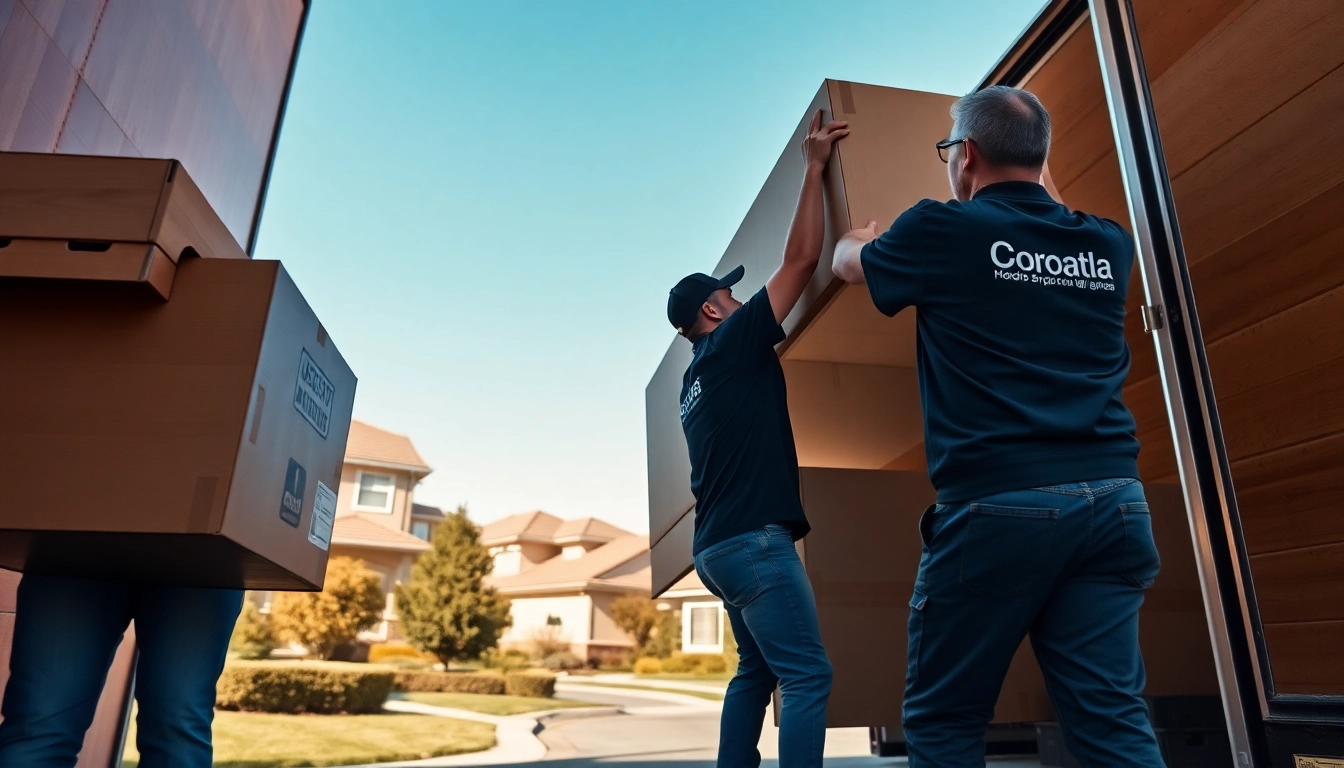Understanding the Basics of House Moves
When it comes to relocating, the term house moves covers a wide range of logistics and emotional considerations. Moving from one residence to another can be one of life’s most stressful events, but understanding the fundamentals can ease this burden significantly. In this section, we will explore what house moves entail, key factors that need to be considered before making a move, and how to effectively plan your moving timeline.
What are House Moves?
House moves refer to the process of relocating household goods from one home to another. This can involve various types of moves, such as local moves within the same city, long-distance relocations to a different state, or even international moves. Each type of house move requires specific planning and preparation, tailored to the distance, regulations, and the volume of belongings being transported.
Additionally, house moves often involve a combination of physical, logistical, and emotional dimensions. The process includes sorting through possessions, deciding what to keep or discard, packing, loading, transporting, unloading, and unpacking. As such, extensive planning is essential to ensure that no aspect of the move is overlooked.
Key Considerations Before Moving
Before initiating any house move, several key considerations should be addressed to ensure a smoother transition:
- Budget: Determine how much you can afford to spend on the move. Include costs such as moving supplies, hired moving services, transportation, and additional expenses.
- Timing: Choose a moving date that works best for your schedule. Take into account local factors such as weather, moving company availability, and the housing market.
- Distance: Understand the distance to your new home, as this affects logistics, costs, and the time required for the move.
- Size of Move: Evaluate how much furniture and belongings need to be moved. This will dictate whether you’ll need professional help or if you can manage the move yourself.
- Moving Method: Decide whether you will hire a moving company, rent a truck, or use a portable storage unit. Each option has its pros and cons.
- Restrictions: Consider any restrictions or regulations regarding moving in your area, such as zoning laws or homeowners’ association rules.
Planning Your Move Timeline
Creating a timeline for your move is crucial for avoiding last-minute chaos. A well-structured timeline generally begins at least 8 weeks before the moving date.
- 8 Weeks Before: Start decluttering by sorting items into keep, donate, and discard categories. Begin gathering packing supplies.
- 6 Weeks Before: Notify your landlord if you’re renting, and hold a garage sale for items you don’t want. Start packing non-essential items.
- 4 Weeks Before: Order moving supplies, confirm your moving date with the company (if applicable), and start packing room by room.
- 2 Weeks Before: Finalize change-of-address documents, schedule utility transfers, and confirm any childcare or pet care arrangements.
- 1 Week Before: Pack a “first-night” bag with essentials and finalize packing. Double-check your timeline and ensure everything is in place.
- Day Before: Do a walkthrough of your home to ensure nothing is left behind and confirm arrangements with your movers.
Preparing for a Successful House Move
Preparation is key to ensuring a smooth house move. From creating checklists to making informed choices about supplies, the following sections will delve into essential components that contribute to a successful relocation.
Creating a Moving Checklist
A moving checklist serves as a tangible guide through the various stages of your move. Here’s a template checklist:
- Declutter and sort items.
- Gather packing supplies.
- Notify the landlord or sell your home.
- Change of address notifications.
- Plan for utility setups at the new location.
- Book moving truck or professional movers.
- Pack items responsibly, labeling boxes by room and contents.
- Prepare the new home for your belongings.
- Conduct a final sweep of the old home.
Keeping this checklist updated can help manage tasks throughout the moving process.
Packing Tips for House Moves
Packing can often be overwhelming, but with efficient strategies, it can be managed effectively:
- Start Early: Begin packing non-essential items as soon as you know you’ll be moving.
- Room by Room: Pack one room at a time and keep similar items together for easier unpacking.
- Use Quality Materials: Invest in sturdy boxes, bubble wrap, and packing tape to protect your belongings.
- Label Everything: Clearly label boxes with their contents and the room they belong in to streamline unpacking.
- Fill Boxes: Don’t leave empty space in boxes; fill with packing material to prevent shifting during transport.
- Essentials Box: Have a separate box containing necessary items for your first few days in your new home, such as toiletries, snacks, and chargers.
Choosing the Right Moving Supplies
Choosing the proper moving supplies can greatly impact the efficiency of your move. Essential moving supplies and their considerations include:
- Boxes: Opt for various sizes, including small, medium, and large boxes to accommodate different items.
- Bubble Wrap and Packing Paper: These materials are crucial for protecting fragile items.
- Tape and Dispensers: Strong packing tape is essential for securing boxes, while dispensers can speed up the process.
- Markers: Use permanent markers for labeling boxes clearly. Color-coding can also help when organizing by room.
- Furniture Pads: Essential for protecting larger furniture items during transport.
Hiring Professionals for Your House Moves
Many individuals opt to hire professionals to simplify their moving experience. This section will cover the benefits of professional movers and important factors to consider when selecting a moving company.
Benefits of Professional Movers
Engaging professional movers can alleviate much of the stress associated with moving. Here are key benefits:
- Expertise: Professionals have experience with packing, loading, and transporting a variety of items safely and efficiently.
- Time Savings: Hiring movers can save significant time, allowing you to focus on other important aspects of the transition.
- Proper Equipment: Moving companies have the necessary tools and equipment to handle heavy and bulky items, reducing the risk of injury.
- Insurance Options: Most reputable moving companies offer insurance options to protect your belongings in transit.
- Less Stress: Outsourcing the physical and logistical aspects allows you to concentrate on settling into your new home.
How to Select a Reliable Moving Company
Choosing the right moving company is essential to a smooth move. Here’s how to ensure you make a reliable choice:
- Research: Look for reviews online, ask friends or family for recommendations, and check professional organizations.
- Get Quotes: Obtain multiple quotes from different companies to compare services and prices. Ensure quotes are detailed and transparent.
- Verify Credentials: Ensure the company is licensed and insured; check their authority on the Federal Motor Carrier Safety Administration (FMCSA) website.
- Discuss Policies: Clarify the company’s policies regarding cancellations, delays, damages, and insurance coverage. Ask about their handling of specialty items.
- On-Site Assessments: Prefer companies that offer an on-site assessment before providing a quote. This helps ensure estimates are accurate.
Understanding Moving Insurance and Liability
Moving insurance protects your belongings during the move. Understanding the types of insurance available can help you make informed decisions:
- Basic Coverage: This option is typically offered as part of the moving contract and covers your possessions based on weight, not actual value.
- Full Value Protection: For a premium, this type of coverage ensures you can receive the repair or replacement value for items lost or damaged during the move.
- Third-Party Insurance: You may also consider additional third-party insurance options that offer further coverage; compare policies and benefits before purchasing.
- Liability Waivers: Understand what damages or losses you may not be covered for, and ask your moving company to clarify their liability limits.
Executing a Stress-Free House Move
Once everything is planned and organized, executing the actual move is the next phase. At this stage, the goal is to ensure everything goes according to plan and mitigate unexpected challenges.
Day-of Moving Tips
The moving day can be hectic. To ensure a smooth operation, consider the following tips:
- Confirm Details: Ensure that everyone involved is aware of the plans, and confirm the arrival time with the moving company.
- Keep Essentials Accessible: Have your essentials box handy, filled with items you may need immediately.
- Supervise the Loading: It’s crucial to supervise the loading process to avoid damages and ensure everything is handled carefully.
- Stay Organized: As boxes are loaded, keep a checklist of what has been moved to help with inventory.
- Maintain Communication: Keep lines of communication open with movers and anyone else involved in the process during the day.
Managing Logistics and Transportation
Logistics play a significant role in the success of your move. Effective management includes:
- Loading Order: Load heavier items first to balance the truck. Fragile items should be loaded last and marked carefully.
- Transportation Route: Ensure you have a planned route to the destination, considering traffic and road conditions.
- Utility Setup: Verify that utilities are scheduled for activation at your new home to avoid inconvenience.
- Check Inventory: As items arrive at the new location, check them off your list to ensure nothing is missing.
Unpacking and Settling into Your New Home
Once you’ve arrived at your new home, the unpacking process begins. Here are steps to streamline this transition:
- Prioritize Essentials: Start by unpacking the essentials that you need for daily living before tackling smaller items.
- Room-by-Room: Focus on one room at a time, allowing for better organization and a feeling of accomplishment.
- Construct Furniture First: Set up beds and larger furniture first to ensure you have a place to sleep and relax.
- Organize Items: As you unpack, arrange items thoughtfully to enhance both aesthetics and functionality.
- Take Your Time: Don’t rush the unpacking process. Make it comfortable to settle into your new space.
Post-Move Considerations and Tips
After the dust settles from your move, it’s essential to address certain post-move tasks to fully acclimate to your new environment.
Updating Your Address and Important Documents
One of the first things you should do after moving is to update your address everywhere necessary:
- Postal Service: File a change of address with the postal service to forward any mail to your new address.
- Services and Subscriptions: Update details with magazines, subscriptions, and online services.
- Bank and Other Financial Institutions: Update your address with your bank, credit card companies, and other financial entities.
- Emergency Contacts: Ensure that medical providers and emergency contacts have your new address on file.
Evaluating the Move: What Went Well?
After settling in, reflect on your moving experience to identify successes and areas for improvement:
- What Stood Out: Assess which aspects of your move were handled effectively and contributed to a positive experience.
- Challenges Faced: Identify any issues that arose, whether related to timing, logistics, or organization.
- Feedback for Movers: If you hired a moving company, consider leaving feedback based on your experience.
How to Share Your Moving Experience
Sharing lessons learned from your move can benefit others. Consider these options:
- Social Media: Post about your moving process on social networks, sharing tips and photos.
- Blogging or Vlogging: If you enjoy writing or filming, create content explaining your journey for others navigating similar experiences.
- Community Forums: Engage with local community groups to share insights and learn from others’ experiences.



